-
Executive Summary
-
Market Introduction
-
Market Definition
-
Scope of the Study
-
List of Assumptions
-
Markets Structure
-
Market Research Methodology
-
Research Process
-
Primary Research
-
Secondary Research
-
Market Size Estimation
-
Forecast Model
-
Market Dynamics of the Global Sheet Metal Market
-
Introduction
-
Drivers
-
Restraints
-
Opportunities
-
Challenges
-
Trends/Technology
-
Market Factor Analysis of the Global Sheet Metal Market
-
Supply Chain Analysis
- Raw Material Type Suppliers
- Manufacturers/Producers
- Distributors/Retailers/Wholesalers/E-Commerce
- End-Use Industry
-
Porter’s Five Forces Analysis
- Threat of New Entrants
- Bargaining Power of Buyers
- Bargaining Power of Suppliers
- Threat of Substitutes
- Intensity of Competitive Rivalry
-
Pricing Analysis
-
Global Sheet Metal Market, by Material Type
-
Introduction
-
Steel
- Market Estimates & Forecast, 2022-2030
- Market Estimates & Forecast, by Region, 2022-2030
-
Aluminum
- Market Estimates & Forecast, 2022-2030
- Market Estimates & Forecast, by Region, 2022-2030
-
Others
- Market Estimates & Forecast, 2022-2030
- Market Estimates & Forecast, by Region, 2022-2030
-
Global Sheet Metal Market, by Process
-
Introduction
-
Rolling
- Market Estimates & Forecast, 2022-2030
- Market Estimates & Forecast, by Region, 2022-2030
-
Forging
- Market Estimates & Forecast, 2022-2030
- Market Estimates & Forecast, by Region, 2022-2030
-
Bending
- Market Estimates & Forecast, 2022-2030
- Market Estimates & Forecast, by Region, 2022-2030
-
Others
- Market Estimates & Forecast, 2022-2030
- Market Estimates & Forecast, by Region, 2022-2030
-
Global Sheet Metal Market, by End-Use Industry
-
Introduction
-
Automotive & Transportation
- Market Estimates & Forecast, 2022-2030
- Market Estimates & Forecast, by Region, 2022-2030
-
Building & Construction
- Market Estimates & Forecast, 2022-2030
- Market Estimates & Forecast, by Region, 2022-2030
-
Consumer Appliances
- Market Estimates & Forecast, 2022-2030
- Market Estimates & Forecast, by Region, 2022-2030
-
Energy
- Market Estimates & Forecast, 2022-2030
- Market Estimates & Forecast, by Region, 2022-2030
-
Others
- Market Estimates & Forecast, 2022-2030
- Market Estimates & Forecast, by Region, 2022-2030
-
Global Sheet Metal Market, by Region
-
Introduction
-
North America
- Market Estimates & Forecast, 2022-2030
- Market Estimates & Forecast, by Material Type, 2022-2030
- Market Estimates & Forecast, by Process, 2022-2030
- Market Estimates & Forecast, by End-Use Industry, 2022-2030
- US
- Canada
-
Europe
- Market Estimates & Forecast, 2022-2030
- Market Estimates & Forecast, by Material Type, 2022-2030
- Market Estimates & Forecast, by Process, 2022-2030
- Market Estimates & Forecast, by End-Use Industry, 2022-2030
- Germany
- France
- Italy
- Spain
- UK
- Russia
- Poland
- Rest of Europe
-
Asia-Pacific
- Market Estimates & Forecast, 2022-2030
- Market Estimates & Forecast, by Material Type, 2022-2030
- Market Estimates & Forecast, by Process, 2022-2030
- Market Estimates & Forecast, by End-Use Industry, 2022-2030
- China
- India
- Japan
- Australia & New Zealand
- Rest of Asia-Pacific
-
Middle East & Africa
- Market Estimates & Forecast, 2022-2030
- Market Estimates & Forecast, by Material Type, 2022-2030
- Market Estimates & Forecast, by Process, 2022-2030
- Market Estimates & Forecast, by End-Use Industry, 2022-2030
- GCC
- Israel
- North Africa
- Turkey
- Rest of Middle East & Africa
-
Latin America
- Market Estimates & Forecast, 2022-2030
- Market Estimates & Forecast, by Material Type, 2022-2030
- Market Estimates & Forecast, by Process, 2022-2030
- Market Estimates & Forecast, by End-Use Industry, 2022-2030
- Brazil
- Mexico
- Argentina
- Rest of Latin America
-
Company Landscape
-
Introduction
-
Market Strategies
-
Key Development Analysis (Expansion/Merger & Acquisition/Joint Venture/New Product Development/Agreement/Investment)
-
Company Profiles
-
NIPPON STEEL CORPORATION
- Company Overview
- Financial Updates
- Product/Business Segment Overview
- Key Strategies
- Key Developments
- SWOT Analysis
-
POSCO
- Company Overview
- Financial Updates
- Product/Business Segment Overview
- Key Strategies
- Key Developments
- SWOT Analysis
-
JFE Steel Corporation
- Company Overview
- Financial Updates
- Product/Business Segment Overview
- Key Strategies
- Key Developments
- SWOT Analysis
-
Baosteel Group
- Company Overview
- Financial Updates
- Product/Business Segment Overview
- Key Strategies
- Key Developments
- SWOT Analysis
-
Norsk Hydro ASA
- Company Overview
- Financial Updates
- Product/Business Segment Overview
- Key Strategies
- Key Developments
- SWOT Analysis
-
Aronic
- Company Overview
- Financial Updates
- Product/Business Segment Overview
- Key Strategies
- Key Developments
- SWOT Analysis
-
Alcoa Corporation
- Company Overview
- Financial Updates
- Product/Business Segment Overview
- Key Strategies
- Key Developments
- SWOT Analysis
-
Aditya Birla Management Corporation Pvt. Ltd
- Company Overview
- Financial Updates
- Product/Business Segment Overview
- Key Strategies
- Key Developments
- SWOT Analysis
-
United States Steel
- Company Overview
- Financial Updates
- Product/Business Segment Overview
- Key Strategies
- Key Developments
- SWOT Analysis
-
Aleris Corporation
- Company Overview
- Financial Updates
- Product/Business Segment Overview
- Key Strategies
- Key Developments
- SWOT Analysis
-
Constellium
- Company Overview
- Financial Updates
- Product/Business Segment Overview
- Key Strategies
- Key Developments
- SWOT Analysis
-
Kaiser Aluminum
- Company Overview
- Financial Updates
- Product/Business Segment Overview
- Key Strategies
- Key Developments
- SWOT Analysis
-
Hulamin
- Company Overview
- Financial Updates
- Product/Business Segment Overview
- Key Strategies
- Key Developments
- SWOT Analysis
-
Conclusion
-
LIST OF TABLES
-
Global Sheet Metal Market, by Region, 2022-2030
-
North America: Sheet Metal Market, by Country, 2022-2030
-
Europe: Sheet Metal Market, by Country, 2022-2030
-
Asia-Pacific: Sheet Metal Market, by Country, 2022-2030
-
Middle East & Africa: Sheet Metal Market, by Country, 2022-2030
-
Latin America: Sheet Metal Market, by Country, 2022-2030
-
Global Sheet Metal Material Type Market, by Regions, 2022-2030
-
North America: Sheet Metal Material Type Market, by Country, 2022-2030
-
Europe: Sheet Metal Material Type Market, by Country, 2022-2030
-
Table10 Asia-Pacific: Sheet Metal Material Type Market, by Country, 2022-2030
-
Table11 Middle East & Africa: Sheet Metal Material Type Market, by Country, 2022-2030
-
Table12 Latin America: Sheet Metal Material Type Market, by Country, 2022-2030
-
Table13 Global Sheet Metal Process Market, by Regions, 2022-2030
-
Table14 North America: Sheet Metal by Process Market, by Country, 2022-2030
-
Table15 Europe: Sheet Metal Process Market, by Country, 2022-2030
-
Table16 Asia-Pacific: Sheet Metal Process Market, by Country, 2022-2030
-
Table17 Middle East & Africa: Sheet Metal Process Market, by Country, 2022-2030
-
Table18 Latin America: Sheet Metal Process Market, by Country, 2022-2030
-
Table19 Global Sheet Metal End-Use Industry Market, by Regions, 2022-2030
-
Table20 North America: Sheet Metal End-Use Industry Market, by Country, 2022-2030
-
Table21 Europe: Sheet Metal End-Use Industry Market, by Country, 2022-2030
-
Table22 Asia-Pacific: Sheet Metal End-Use Industry Market, by Country, 2022-2030
-
Table23 Middle East & Africa: Sheet Metal End-Use Industry Market, by Country, 2022-2030
-
Table24 Latin America: Sheet Metal End-Use Industry Market, by Country, 2022-2030
-
Table25 Global Material Type Market, by Region, 2022-2030
-
Table26 Global Process Market, by Region, 2022-2030
-
Table27 Global End-Use Industry Market, by Region, 2022-2030
-
Table28 North America: Sheet Metal Market, by Country
-
Table29 North America: Sheet Metal Market, by Material Type
-
Table30 North America: Sheet Metal Market, by Process
-
Table31 North America: Sheet Metal Market, by End-Use Industry
-
Table32 Europe: Sheet Metal Market, by Country
-
Table33 Europe: Sheet Metal Market, by Material Type
-
Table34 Europe: Sheet Metal Market, by Process
-
Table35 Europe: Sheet Metal Market, by End-Use Industry
-
Table36 Asia-Pacific: Sheet Metal Market, by Country
-
Table37 Asia-Pacific: Sheet Metal Market, by Material Type
-
Table38 Asia-Pacific: Sheet Metal Market, by Process
-
Table39 Asia-Pacific: Sheet Metal Market, by End-Use Industry
-
Table40 Middle East & Africa: Sheet Metal Market, by Country
-
Table41 Middle East & Africa: Sheet Metal Market, by Material Type
-
Table42 Middle East & Africa: Sheet Metal Market, by Process
-
Table43 Middle East & Africa: Sheet Metal Market, by End-Use Industry
-
Table44 Latin America: Sheet Metal Market, by Country
-
Table45 Latin America: Sheet Metal Market, by Material Type
-
Table46 Latin America: Sheet Metal Market, by Process
-
Table47 Latin America: Sheet Metal Market, by End-Use Industry
-
LIST OF FIGURES
-
Global Sheet Metal Market Segmentation
-
Forecast Research Methodology
-
Five Forces Analysis of the Global Sheet Metal Market
-
Value Chain of the Global Sheet Metal Market
-
Share of the Global Sheet Metal Market in 2022, by Country (%)
-
Global Sheet Metal Market, 2022-2030
-
Global Sheet Metal Market Size, by Material Type, 2022
-
Share of the Global Sheet Metal Market, by Material Type, 2022-2030
-
Global Sheet Metal Market Size, by Process, 2022
-
Share of the Global Sheet Metal Market, by Process, 2022-2030
-
Global Sheet Metal Market Size, by End-Use Industry, 2022
-
Share of the Global Sheet Metal Market, by End-Use Industry, 2022-2030'


 Source: Secondary Research, Primary Research, Market Research Future Database and Analyst Review
Source: Secondary Research, Primary Research, Market Research Future Database and Analyst Review





Leave a Comment